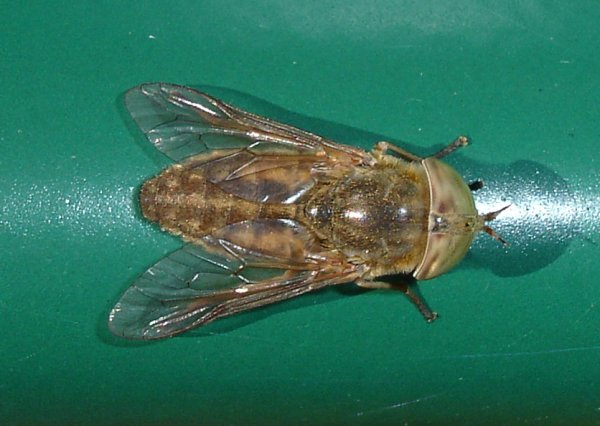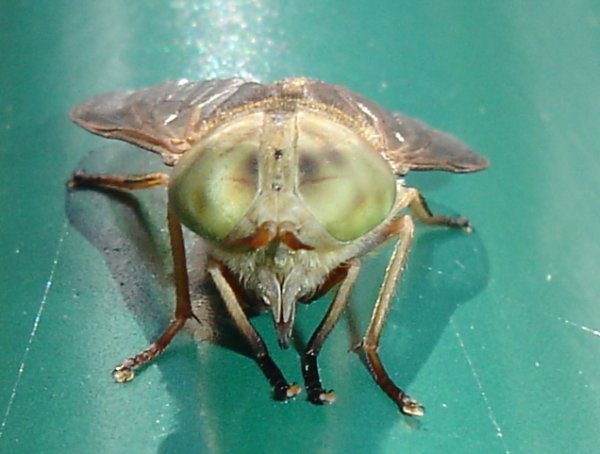Diptera.info :: Identification queries :: Diptera (adults)
Who is here? 1 guest(s)
|
Another Atylotus
|
|
| Smoggycb |
Posted on 30-07-2007 14:37
|
|
Member Location: Rye Harbour, England Posts: 350 Joined: 19.05.07 |
Photographed on an area of waste ground equidistant between saltmarsh and grazing marsh.
Smoggycb attached the following image:  [48.18Kb] |
|
|
|
| Smoggycb |
Posted on 30-07-2007 14:38
|
|
Member Location: Rye Harbour, England Posts: 350 Joined: 19.05.07 |
Another view
Smoggycb attached the following image:  [34.43Kb] |
|
|
|
| Smoggycb |
Posted on 30-07-2007 14:39
|
|
Member Location: Rye Harbour, England Posts: 350 Joined: 19.05.07 |
...and another
Smoggycb attached the following image:  [43.43Kb] |
|
|
|
| Zeegers |
Posted on 30-07-2007 16:43
|
|
Member Location: Soest, NL Posts: 19208 Joined: 21.07.04 |
Congratulations. This is (95 % sure) latistriatus. If you can see hairs on the eyes with a 10 x loup, it's 100 % (have a good look again dark background !) Theo |
|
|
|
| Zeegers |
Posted on 30-07-2007 17:55
|
|
Member Location: Soest, NL Posts: 19208 Joined: 21.07.04 |
I think I can even see some hairs on the pictures (??) Theo |
|
|
|
| Smoggycb |
Posted on 30-07-2007 18:36
|
|
Member Location: Rye Harbour, England Posts: 350 Joined: 19.05.07 |
Thanks Theo. I have checked the eyes and they appear to be sparsely pale hairy using a 20x lens. Is that still ok for latistriatus? |
|
|
|
| Smoggycb |
Posted on 30-07-2007 20:14
|
|
Member Location: Rye Harbour, England Posts: 350 Joined: 19.05.07 |
Actually, the hairs appear quite dense from some angles, though they are still quite difficlt to see
Edited by Smoggycb on 30-07-2007 20:15 |
|
|
|
| Zeegers |
Posted on 30-07-2007 20:23
|
|
Member Location: Soest, NL Posts: 19208 Joined: 21.07.04 |
Yes, that's it. It is not soo easy to see, but in rusticus you see completely nothing with a hand lens. Moreover, the pattern on the tergites is slightly different, the legs and notopleurae are more yellow and so on (all very subtle, agreed) So you got both rusticus and latistriatus in the same locality in two weeks time ! Theo |
|
|
|
| Tony T |
Posted on 30-07-2007 22:01
|
|
Member Location: New Brunswick, Canada Posts: 664 Joined: 08.02.07 |
Head shots agree nicely with Verrall's (1909) description of the female eyes "opalescent green with peculiar shifting spots according to the poinrt of view, and these spots are rather few in number and not arranged in rows, but there is also a slight crossband" |
|
|
|
| Smoggycb |
Posted on 31-07-2007 08:20
|
|
Member Location: Rye Harbour, England Posts: 350 Joined: 19.05.07 |
Thanks Theo and Tony. It was the eyes which really drew me to this one in the first place (quite apart from being a large horsefly which always gets my attention!). Both of these species are new to the reserve I work on, though I think I am the first warden who has had any real interest in diptera. However, as i have been here for several years and always have my eyes open for horseflies they must be pretty thinly spread and it does make me wonder about Theo's migrant suggestion in my earlier Atylotus thread, particularly in relation to the A. rusticus record. I've certainly had a few migrants in my moth trap over the last few weeks. |
|
|
|
| Tony T |
Posted on 31-07-2007 09:45
|
|
Member Location: New Brunswick, Canada Posts: 664 Joined: 08.02.07 |
We have several spp. of Atylotus in New Brunswick (Canada) and all are extremely habitat specific. From the few I have seen, and I've been chasing them for 33 years, they are sluggish flyers and keep low down in the vegetation. They don't give the impression of even being capable of migration. I would not be surprised if most species, including UK ones, are autogenous for the first gonotrophic cycle. If so, this may account for their apparent rarity. Try running a Malaise trap on the marsh. |
|
|
|
| Zeegers |
Posted on 31-07-2007 17:10
|
|
Member Location: Soest, NL Posts: 19208 Joined: 21.07.04 |
be assured that latistriatus is a fierce biter ! (other than many other Atylotus, as correctly observed) Theo |
|
|
|
| Jump to Forum: |












